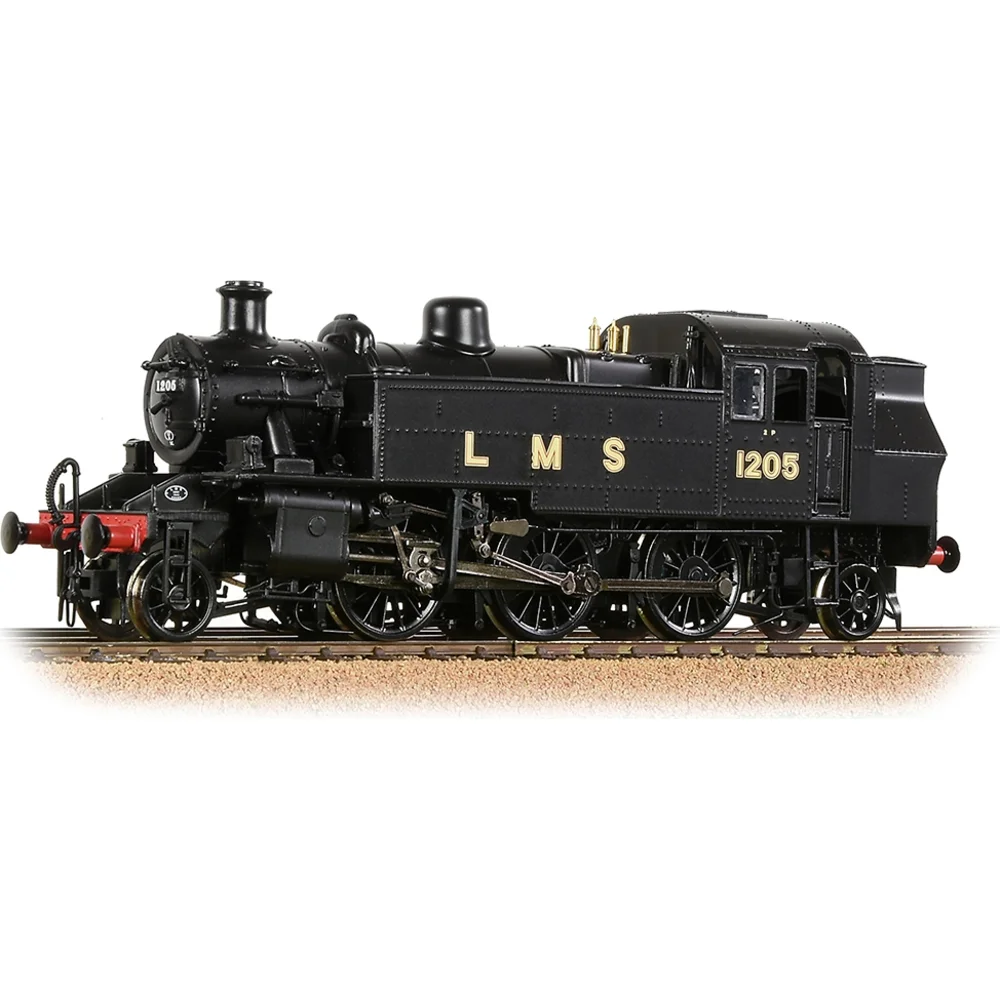Bachmann 31-442
London, Midland & Scottish Railway Ivatt Class 2 2-6-2T 1205 London, Midland & Scottish Railway Black
Tooling
In 2016, Bachmann Branchline unveiled a completely retooled model of the LMS Ivatt Class 2MT 2-6-2T, replacing its original 1995 tooling. This new version was designed to meet modern standards in detailing, performance, and digital compatibility. The prototype, designed by H.G. Ivatt, was introduced in 1946 for mixed-traffic duties and became a staple on branch lines across LMS and later British Railways regions. The 2016 model reflects the preserved examples and operational history with enhanced fidelity.
Tooling Features
- Scale: OO Gauge (1:76)
- Construction: Plastic bodyshell with fine separately fitted details
- Detailing: Turned brass safety valves and whistle, separately fitted handrails, pipework, bufferbeam details, and cab interior
- Couplings: NEM pockets with tension lock couplings
- Finish: Chemically blackened wheels and correct-thickness stamped rods
Mechanical & Electrical Specification
- Chassis: Lightweight chassis with loco-driven wheels
- Motor: Coreless motor located in the locomotive body
- Drive: Drive to two powered axles
- Minimum Radius: Compatible with Radius 2 curves (438mm)
- Weighting: Internal chassis weighting for improved adhesion
- Electrical Pickup: Driving wheels only
- Lighting: No factory lighting; firebox glow and other effects can be added via DCC
DCC Capability
The 2016 tooling is fully DCC Ready with an 18-pin socket located under the cab roof. While no speaker is pre-installed, there is space in the boiler for a sugar cube speaker, making sound installation straightforward. The model supports advanced decoder features including firebox glow and directional lighting when fitted with appropriate hardware. Sound-fitted versions have been released using Zimo decoders.
Liveries Produced
- LMS Black (1923–1947)
- BR Black with British Railways Lettering (1948–1951)
- BR Black with Early Emblem (1949–1957)
- BR Black with Late Crest (1957–1968)
- Preservation Liveries (e.g., KWVR Maroon)
Reviews & Commentary
The 2016 model received widespread praise for its accuracy, smooth running, and ease of DCC installation. Reviewers highlighted the crisp lining, flush glazing, and realistic valve gear motion. The coreless motor offers quiet and reliable performance, though some users noted the lack of tender pickups as a minor drawback. Overall, the model is considered a significant upgrade over the 1995 version.
Media & Social Media
Model railway forums and YouTube channels have featured the 2MT extensively, especially in DCC sound installation guides and layout running sessions. The model is popular among enthusiasts recreating BR branch lines and preservation scenes. The YouChoos installation guide for sound and firebox glow is particularly well-regarded for its clarity and ease of use.
Video Reviews
- Sam’s Trains Review – "Rip-Off Bachmann Ivatt 2MT Tank Engine"
- SDJR7F88 Review – "Bachmann 31-440 Ivatt Class 2MT 2-6-2 Tank"
- Hornby Magazine Review – "HM111: Bachmann re-chassised Ivatt '2MT' 2-6-2T"
Additional Notes
Accessory packs include optional bufferbeam details, vacuum pipes, and cosmetic couplings. The model is compatible with standard OO gauge track and controllers. Replacement parts and upgrade kits are available through Bachmann’s spares service and third-party suppliers.
Bachmann's Description & Specifications
Featuring a detailed and true-to-prototype bodyshell coupled with a high performance chassis, which is driven by a five pole motor and complete with a Next18 DCC decoder socket and space for a speaker, this model is sure to be popular with LMS enthusiasts and adds another tank engine to the LMS locomotive fleet.
Class & Prototype
- Class: London, Midland & Scottish Railway Ivatt Class 2 2-6-2T
- Traction: Steam
- Built: 1946-1952
- Total Built: 130
- Running Number: 1205
Operator & Livery
- Operator: London, Midland & Scottish Railway
- Livery: Black
- Era: 3 - The big 4 – LMS, GWR, LNER & SR
The London, Midland & Scottish Railway (LMS) was Britain's largest railway company from 1923-1948, formed by merging over 120 independent railways under the Railways Act 1921. Operating 7,790 route miles across England, Scotland, Wales, and Northern Ireland, the LMS became the world's largest transport organisation and the British Empire's biggest commercial enterprise. Famous for iconic locomotives like the streamlined Princess Coronation class, versatile Black Fives, and Royal Scots, the company evolved from inherited pre-grouping designs to revolutionary Stanier innovations. The LMS operated major routes including the West Coast Main Line from London Euston to Scotland, serving as the UK's second-largest employer after the Post Office. Nationalised in 1948 to form British Railways' London Midland Region, the LMS legacy continues through extensive preservation efforts and remains a favourite subject for railway modellers seeking authentic British steam-age prototypes.
The LMS plain black livery served as the standard finish for freight locomotives and represented practical railway economics during the company's existence. Applied without lining or embellishment, this utilitarian scheme recognised that goods engines operated in inherently dirty conditions where elaborate paintwork proved both expensive and impractical.
Most LMS freight classes including the ubiquitous 0-6-0 goods engines, 0-8-0 heavy freight locomotives, and tank engines used for shunting duties wore plain black throughout their service lives. The scheme extended beyond locomotives to goods wagons, where black paint provided adequate weather protection at minimal cost.
During World War II, plain black became increasingly common as material shortages and wartime economies forced the abandonment of more elaborate liveries. Even some passenger locomotives temporarily adopted unlined black finishes when crimson lake supplies became unavailable. The practical benefits of black paint - its ability to hide dirt, soot, and industrial grime - made it ideal for locomotives working coal trains, mineral traffic, and heavy industrial duties.
For modellers, plain black represents the workhorse reality of LMS operations, particularly appropriate for freight yards, colliery branches, and industrial settings where authentic weathering and operational realism take precedence over passenger train glamour.
